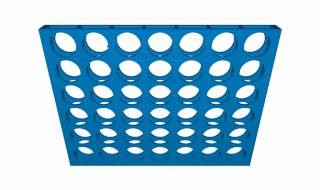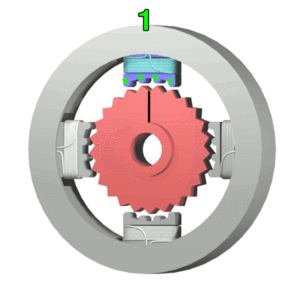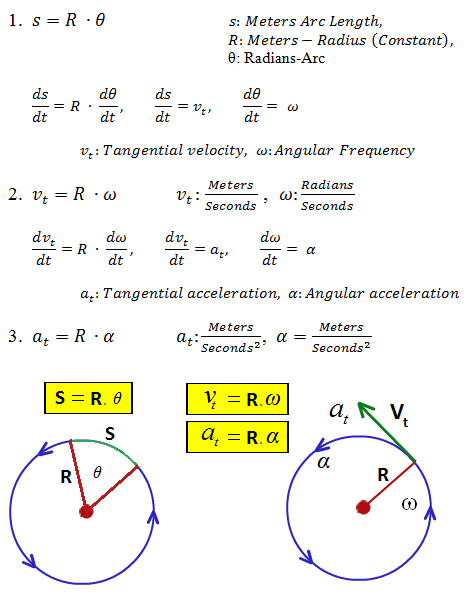Difference between revisions of "S15: Connect Four - Robotic Player"
(→Design & Implementation) |
(→Design & Implementation) |
||
| Line 338: | Line 338: | ||
}); | }); | ||
</syntaxhighlight> | </syntaxhighlight> | ||
| − | + | </br> | |
| + | </br> | ||
Functions are involved during FreeRTOS' implicit 'void run(void)' function by calling the following helper: | Functions are involved during FreeRTOS' implicit 'void run(void)' function by calling the following helper: | ||
| − | + | </br> | |
| + | </br> | ||
<syntaxhighlight lang="cpp"> | <syntaxhighlight lang="cpp"> | ||
| − | void | + | bool run(void *p) |
{ | { | ||
| − | + | pPixy->vAction(SW.getSwitchValues()); | |
| − | + | return true; | |
| − | |||
| − | |||
| − | |||
| − | |||
} | } | ||
</syntaxhighlight> | </syntaxhighlight> | ||
| − | + | </br> | |
| − | + | </br> | |
| − | |||
===== PixyBrain ===== | ===== PixyBrain ===== | ||
Revision as of 10:10, 23 May 2015
Contents
Grading Criteria
- How well is Software & Hardware Design described?
- How well can this report be used to reproduce this project?
- Code Quality
- Overall Report Quality:
- Software Block Diagrams
- Hardware Block Diagrams
- Schematic Quality
- Quality of technical challenges and solutions adopted.
Artificially-Intelligent Connect Four Robot
Abstract
Play Connect Four against an Artificially Intelligent robot with variable difficulty. Prepare to test your ability to think into the future and your proficiency at connecting your pieces against an ideal player. Connect Four
Objectives & Introduction
The objectives of this project is to implement a robotic connect four player with the same capabilities as a human being with respect to the task of connecting pieces by inserting them into one of seven columns at the top of the board. Just as a human can see where his opponent has played his move and can insert his next move into the board, this robot will implement imitations of these basic human abilities.
Team Members & Responsibilities
Matthew Carlis (Jack of all Trades) - Hardware/Mechanical,
Artificial Intelligence,
System Architect,
Technical Writer.
Alexander Koumis (Image/Driver Guru) - Drivers,
Image Processing,
Software Interfaces.
Status Video: https://www.youtube.com/watch?v=txRglMCjcsI&feature=youtu.be
Schedule
| Story# | Points | Task | Description |
|---|---|---|---|
| 1 | 15 | Motor Controller | Write a Stepper motor driver with variable frequency capabilities with constant linear acceleration. This driver should slowly speed up the motor and slowly bring it down while being capable of mapping PWM frequency to pulley frequency. |
| 2 | 10 | Bluetooth Socket. | The micro-controller will be run in combination with a workstation using Bluetooth message passing. The workstation will implement the AI programming where the micro-controller simply tells the workstation through Bluetooth where each move is made by the human and is returned the column number of where to insert the robots next piece. The workstation will implement a Python program interface. |
| 3 | 20 | AI Brain. (It's alive!) | A Python program running on an workstation will implement the "Brain" of the robot where messages are passed between the micro-controller and workstation through Bluetooth. This program will determine where the robot will insert his next move based on which column the human inserts into as reported through the Bluetooth message protocol. |
| 4 | 30 | Mechanical System. | The mechanical system be capable of inserting it's own pieces using linear motion and a stepper motor. The robot will drop his piece into a funnel device which is driven over the column for which the robot wishes to play. After his human opponent has inserted his piece the robots eyes will detect the location of the humans insertion and reply by inserting his next piece. |
| 5 | 25 | The Eyes. | Using the pixy camera to determine the current configuration of the Connect Four board for the robotic player. Using statistical filtering by oversampling the frames the robot will be see each piece as it is inserted. |
| Story# | Points | Story | Burn-down | Time Invested | Actual |
|---|---|---|---|---|---|
| 1 | 15 | Motor Controller | 10 | 15 Hours | 22.7% |
| 2 | 10 | Bluetooth Socket. | 5 | 3 Hours | 4.5% |
| 3 | 20 | AI Brain. (It's alive!) | 15 | 18 Hours | 27.3% |
| 4 | 30 | Mechanical System. | 18 | 20+ Hours | 30.3% |
| 5 | 25 | The Eyes. | 10 | 10+ Hours | 15.2% |
| Event# | Date | Task | Actual |
|---|---|---|---|
| 1 | 3/1 | Spec out Design | Completed: Started the system hardware/mechanical specs and materials ordering. Software interfaces are well defined, but not implemented. |
| 2 | 3/18 | Ordered Materials | Completed: Completed mechanical design/research and ordered the majority of the significant materials. (Stepper motor, timing belt/pulleys, liner motion accessories) |
| 3 | 4/1 | Structure Materials | Completed: Received and obtained the majority of the significant materials for the mechanical structure. |
| 4 | 4/20 | Major Milestone | Completed: Bluetooth interface, Stepper Motor Driver, Mechanical specs/ordered, AI implementation. |
| 5 | 4/27 | Projected | ToDo: Finish assembling the mechanical, add linear acceleration to motor driver. |
Parts List & Cost
Give a simple list of the cost of your project broken down by components. Do not write long stories here.
| Qty (Extra) | Description | Manufacturer | Cost |
|---|---|---|---|
| 1 | Stepper Motor Driver 3A | SmartSain | $19.99 |
| 1 | Stepper Motor | Lin Engineering | $45.90 |
| 1 | 24V-40W PSU. | CircuitSpecialists | $14.79 |
| 1 | Pixy Camera CMUcam5 | Pixy | $69.99 |
| 1 | XBee Bluetooth | XBee | $27.95 |
| 2 | Timing Pulley's | N/A | $11.95 (each) |
| 1 | Timing Belt | N/A | $9.95 |
| 4 | Linear Rail Guide | N/A | $3.95 (each) |
| 2 | Linear Bearing w/Platform | N/A | $6.95 (each) |
| 2 | 8mm Linear Motion Rail/Shaft Steel | N/A | $15.25 (each) |
Design & Implementation
System Diagram
The following graphic provides a high-level representation of the system's various software/hardware/human interfaces:
Hardware Design
Discuss your hardware design here. Show detailed schematics, and the interface here.
Hardware Interface
In this section, you can describe how your hardware communicates, such as which BUSes used. You can discuss your driver implementation here, such that the Software Design section is isolated to talk about high level workings rather than inner working of your project.
- Physical Layer Interfaces
- SPI - Pixy Camera
- Bluetooth - Laptop Communication
- PWM (stepper) - 1 Wire PWM with 2 Control Signals.
- PWM (servo) - 2 Wire PWM.
Software Design
The system's software interfaces are comprised of the following components (organized by their respective hardware hosts):
- Laptop
- SJSU One
Bluetooth Socket Interface
Connect 4 AI
GameTask
MotorTask
PixyTask
Drivers for the Pixy were designed using Ozmekian system principles (every machine characteristic/action has a corresponding human analogue). The Pixy's primary tasks as part of Konnector is to send the location and coordinates of human-inserted Connect 4 game chips to the SJSU One board. This involves recording location/coordinate information of incoming blobs, performing statistical analysis on said blobs, and subsequently notifying other system components once a human chip-insertion has been detected. The Pixy's software interface is therefore comprised of the classes PixyBrain, PixyEyes, and PixyMouth, each one encompassing the corresponding facilities that would be required of a human assuming the same role.
Following the same analogy, PixyTask can be thought of as the "consciousness" of the system, interfacing directly only with the 'Pixy' class, which defines actions for the individual components to take in response to recorded state/external input:
template<typename KEY_T, typename FUN_T, typename ... ARG_T>
struct FuncMap_t
{
map<KEY_T, function<FUN_T(ARG_T ... xArgs)>> fpMap;
void vSetHandler(KEY_T xElem, function<FUN_T(ARG_T ... xArgs)> fnHandler)
{
fpMap[xElem] = fnHandler;
}
function<FUN_T(ARG_T ... xArgs)>& vResponse(KEY_T xElem)
{
return fpMap[xElem];
}
};A function is defined to respond to each of the following system states (Github):
enum State_t
{
RESET=0x01, // SW(1)
EMA_ALPHA_UP=0x02, // SW(2)
EMA_ALPHA_DOWN=0x04, // SW(3)
SW_4=0x08, // SW(4)
CALIB=16,
WAITING_FOR_HUMAN=17,
WAITING_FOR_BOT=18,
ERROR=19
} eState, eLastState;The system typically alternates between states 'WAITING_FOR_HUMAN' and 'WAITING_FOR_BOT', defined by the following (pseudo-code) functions:
xFuncMap->vSetHandler(WAITING_FOR_HUMAN, [&] ()
{
int lHumanCol = pPixyBrain->lSampleChips(pPixyEyes.get());
if (lHumanCol > 0)
{
pPixyBrain->vPrintChips(Board_t::COLOR, true);
eState = WAITING_FOR_BOT;
}
else
{
eState = WAITING_FOR_HUMAN;
}
pPixyBrain->vPrintCorners(Board_t::COLOR);
});
xFuncMap->vSetHandler(WAITING_FOR_BOT, [&] ()
{
PixyCmd_t xBotInsertCmd;
if (xQueueReceive(
scheduler_task::getSharedObject(shared_PixyQueue),
&xBotInsertCmd, portMAX_DELAY))
{
ChipColor_t xChipColor = xBotInsertCmd.lColor;
xBotInsertCmd.lColumn;
PixyBrain->lBotInsert(xBotInsertCmd);
eState = WAITING_FOR_HUMAN;
}
else
{
eState = WAITING_FOR_BOT;
}
});</br> </br> Functions are involved during FreeRTOS' implicit 'void run(void)' function by calling the following helper: </br> </br>
bool run(void *p)
{
pPixy->vAction(SW.getSwitchValues());
return true;
}</br> </br>
PixyBrain
PixyEyes
PixyMouth
Implementation
This section includes implementation, but again, not the details, just the high level. For example, you can list the steps it takes to communicate over a sensor, or the steps needed to write a page of memory onto SPI Flash. You can include sub-sections for each of your component implementation.
Testing & Technical Challenges
Describe the challenges of your project. What advise would you give yourself or someone else if your project can be started from scratch again? Make a smooth transition to testing section and described what it took to test your project.
Include sub-sections that list out a problem and solution, such as:
My Issue #1
Discuss the issue and resolution.
Conclusion
Conclude your project here. You can recap your testing and problems. You should address the "so what" part here to indicate what you ultimately learnt from this project. How has this project increased your knowledge?
Project Video
Upload a video of your project and post the link here.
Project Source Code
- Sourceforge Source Code Link (Project Baseline)
- Connect Four:
References
Acknowledgement
Any acknowledgement that you may wish to provide can be included here.
References Used
List any references used in project.
Appendix
You can list the references you used.



